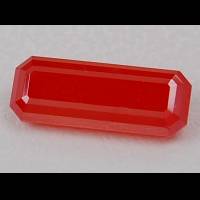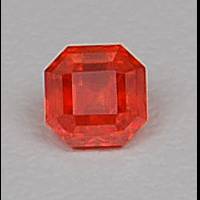Crocoite

Dundas mineral field, Zeehan mining district, West Coast municipality, Tasmania, Australia
4.09 carats
© Rarestone.com
Crocoite is commonly found as well-developed crystals of a bright hyacinth-red, orange, or yellow colour, near transparent to translucent, and have an adamantine to vitreous lustre.
The material is brittle, has good cleavage and very sensitive to heat. Transparent crystals of crocoite have been faceted into brilliant stones for collectors.
Crocoite Gemstones by Colour
This table shows the variety of hues this gemstone can be found in. Click on a photo for more information.
Crocoite Gemstones by Size
This table shows distribution of Crocoite gemstone sizes that are listed on this site. This can give a good indication as to the general availability of this gemstone in different sizes.
Contributed photos
Lightest:1.13 cts
Heaviest:4.20 cts
Average:3.14 cts
Total photos:3
Do you have a larger Crocoite? Why not upload a photo?
| General Information | |||||||||
|---|---|---|---|---|---|---|---|---|---|
| Chemical Formula |
| ||||||||
| Physical Properties of Crocoite | |||||||||
| Mohs Hardness | 2.5 to 3, Gemmological Tables (2004) More from other references | ||||||||
| Specific Gravity | 5.90 to 6.10, Gemmological Tables (2004) More from other references | ||||||||
| Cleavage Quality | Distinct, Gemstones (2009) | ||||||||
| Fracture | Conchoidal, Gemstones (2009) | ||||||||
| Optical Properties of Crocoite | |||||||||
| Refractive Index | 2.31 to 2.66, Gemmological Tables (2004) More from other references | ||||||||
| Optical Character | Biaxial/+, Gemmological Tables (2004) More from other references | ||||||||
| Birefringence | 0.35, Gemmological Tables (2004) More from other references | ||||||||
| Pleochroism | Distinctly trichroic, Gemstones (2009) | ||||||||
| Dispersion | Nil, Gemstones (2009) | ||||||||
| Colour | |||||||||
| Colour (General) | Yellowish-red, orange, Gemmological Tables (2004) More from other references | ||||||||
| Causes of Colour | Yellow to red, O2-→Cr6+ charge transfer, Pragmatic Spectroscopy For Gemologists (2011) | ||||||||
| Transparency | Transparent,Translucent, Gemmological Tables (2004) More from other references | ||||||||
| Lustre | Adamantine,Vitreous, Gemstones (2009) | ||||||||
| Fluorescence & other light emissions | |||||||||
| Fluorescence (General) | A reddish to dark-brown fluorescence may sometimes be seen, Gems, Sixth Edition (2006) | ||||||||
| Crystallography of Crocoite | |||||||||
| Crystal System | Monoclinic, Gemmological Tables (2004) More from other references | ||||||||
| Habit | Prismatic, Gems, Sixth Edition (2006) More from other references | ||||||||
| Geological Environment | |||||||||
| Where found: | It is found in the oxidized zone of lead deposits in association with chromium-bearing rocks., Gems, Sixth Edition (2006) | ||||||||
| Further Information | |||||||||
| Mineral information: | Crocoite information at mindat.org | ||||||||
| Significant Gem Localities | |||||||||
| |||||||||


